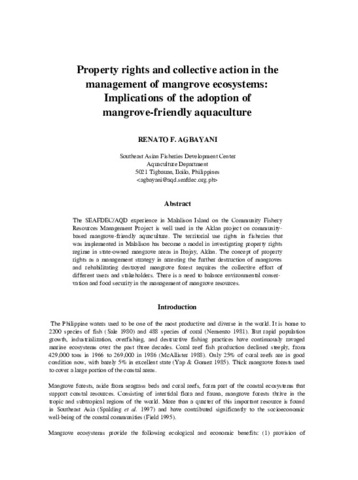Fish habitats in a small, human-impacted Sibunag mangrove creek (Guimaras, Philippines): a basis for mangrove resource enhancement
- Global styles
- MLA
- Vancouver
- Elsevier - Harvard
- APA
- Help
Share
Abstract
The fish assemblage of a small, open access mangrove creek highly influenced by aquaculture farms, was studied for the first time in the Philippines as a baseline of such system as well as examining the degree of ecological disturbance among fish habitats, as basis for the necessity to rehabilitate mangrove resources aiming to balance human activities and mangrove functioning. In total, 475 fishes (total weight = 3875 g) were captured and 50 species representing 32 families were identified. Thirty two species were represented by small numbers (< 5 individuals). Commercial species was considerably high (~23 species) but majority were low grade commercial species. Total species, species diversity and fish abundance consistently showed a decreasing pattern from outside creek to inner creek. Fish habitats exhibited substantial differences following a distinct spatial segregation of fish communities, a dominance of non-shared species and a minimal species overlapping inside the creek, which is attributable to the existing mangrove fragmentation associated with aquaculture ponds in the area. Increasing levels of disturbances were observed within the creek indicating ‘stress’ as a result of overutilization of mangroves by aquaculture farms. Our results confirmed the need to rehabilitate mangrove resources in this area. The development of mangrove resources through reforestation, coupled by strict regulation of fishing activities and aquaculture ponds will reduce ecological stress in the area and regain gradually a robust mangrove functioning that will improve fish diversity, fisheries and productivity of adjacent coastal systems by creating a suitable fish nursery, feeding ground and refuge habitat.
Suggested Citation
Abrogueña, J. B. R., Bagarinao, T., & Chícharo, L. (2012). Fish habitats in a small, human-impacted Sibunag mangrove creek (Guimaras, Philippines): a basis for mangrove resource enhancement. Ecohydrology & Hydrobiology , 12(4), 311-319. https://doi.org/10.2478/v10104-012-0025-z
Type
ArticleISSN
1642-3593Collections
- Journal Articles [1258]
Related items
Showing items related by title, author, creator and subject.
-
Property rights and collective action in the management of mangrove ecosystems: Implications of the adoption of mangrove friendly-aquaculture
Agbayani, Renato F. (Aquaculture Department, Southeast Asian Fisheries Development Center, 2000)The SEAFDEC/AQD experience in Malalison Island on the Community Fishery Resources Management Project is well used in the Aklan project on community-based mangrove-friendly aquaculture. The territorial use rights in fisheries ... -
Advanced broodstock diets for the mangrove red snapper and a potential importance of arachidonic acid in eggs and fry
Emata, Arnil C.; Ogata, Hiroshi Y.; Garibay, Esteban S.; Furuita, Hirofumi (Springer Verlag, 2003)Mangrove red snapper fed advanced broodstock diets containing squid meal and squid oil exhibited higher hatching rates, cumulative survival and survival activity index than those fed a basal diet or a basal diet supplemented ... -
A hatchery rearing method for the mangrove red snapper
Castaños, Milagros T.; Southeast Asian Fisheries Development Center, Aquaculture Department (Aquaculture Department, Southeast Asian Fisheries Development Center, 1997)






